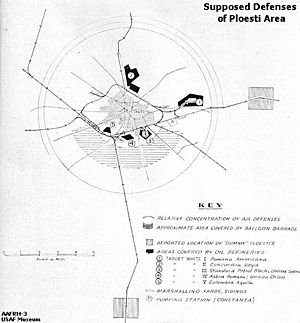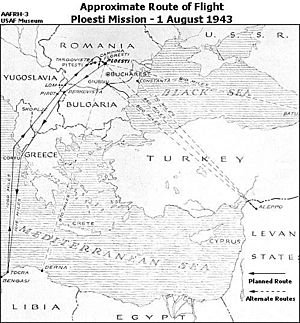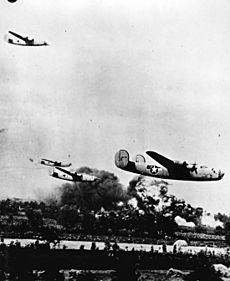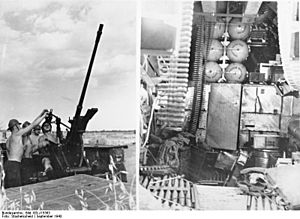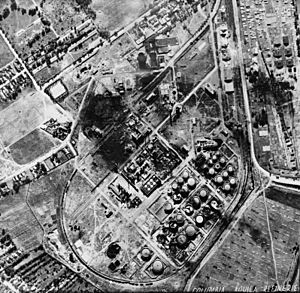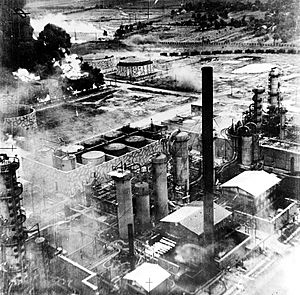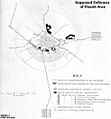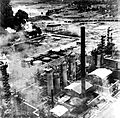Operation Tidal Wave facts for kids
Quick facts for kids Operation Tidal Wave |
|||||||
|---|---|---|---|---|---|---|---|
| Part of Oil Campaign and Eastern Front of World War II | |||||||
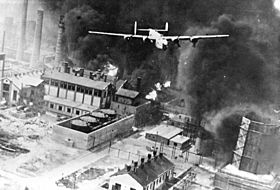 A B-24 Liberator called Sandman during a bomb run over the Ploiești Astra Română refinery during Operation Tidal Wave |
|||||||
|
|||||||
| Belligerents | |||||||
| Commanders and leaders | |||||||
| Strength | |||||||
| 177 B-24s (162 over the target) |
1 German-Romanian Flak Division 1 Romanian AA Brigade 52 fighters |
||||||
| Casualties and losses | |||||||
| 53 B-24s destroyed (35 claimed by Romanians) 55 B-24s damaged 310 aircrew killed or missing 190 aircrew captured or interned |
7 fighters destroyed (2 Romanian and 5 German) |
||||||
| 100 civilians killed and 200 injured (due to an aircraft crash into a prison) | |||||||
Operation Tidal Wave was a major air attack during World War II. On August 1, 1943, bombers from the United States Army Air Forces (USAAF) flew from Libya. Their target was nine important oil refineries near Ploiești, Romania.
This mission was part of a bigger plan called the "oil campaign." The goal was to stop the Axis powers (Germany, Italy, and Japan) from getting the fuel they needed for their war machines. Even though it was a huge effort, the attack did not stop the overall oil production.
Operation Tidal Wave was one of the most difficult and costly air raids for the USAAF. Fifty-three aircraft were lost, and 660 aircrew members were killed or went missing. This day became known as "Black Sunday." Many brave airmen received awards, including five Medals of Honor. A study in 1999 called it "one of the bloodiest and most heroic missions of all time." Sadly, one American plane crashed into a women's prison in Ploiești. This accident caused the deaths of 100 civilians and injured 200 others.
Contents
Planning the Attack
Romania had been a big player in the oil industry since the 1800s. Ploiești was a key area for this production. Its oil refineries supplied about 30% of all the oil used by the Axis powers. This made it a very important target.
Axis Air Defenses
In 1942, an earlier, smaller attack on Ploiești by 13 B-24 Liberators caused little damage. However, it made Germany and Romania set up strong air defenses. German General Alfred Gerstenberg built one of the best defense systems in Europe.
These defenses included hundreds of large anti-aircraft guns. Many smaller guns were hidden in places like haystacks and fake buildings. There were 52 heavy guns and many medium and light anti-aircraft batteries.
The defenses were split between German and Romanian forces. The Axis also had 52 fighter planes ready to defend Ploiești. These included German Bf 109s and Bf 110s, plus Romanian IAR 80 fighters. Because of these strong defenses, Ploiești was one of the most heavily protected targets in all of Axis Europe.
Mission Strategy
The Ninth Air Force was in charge of the raid. The Eighth Air Force also provided three more bomber groups. All the planes used were B-24 Liberators.
Colonel Jacob E. Smart planned the operation. He decided the bombers would fly at a very low altitude. This was to avoid being seen by German radar until the last moment. The crews practiced a lot using detailed models of the target area. They also did practice raids over a fake target in the Libyan desert. The bombers were fitted with extra fuel tanks to fly the long distance.
The plan involved 178 bombers and 1,751 aircrew members. This was one of the largest American bomber missions at that time. The planes took off from airfields near Benghazi, Libya. They were to fly over the Mediterranean and Adriatic Seas. Then, they would cross mountains in Albania and Yugoslavia. Finally, they would enter Romania and turn towards Ploiești. They had to find specific checkpoints and attack all targets at the same time.
For political reasons, the planners wanted to avoid bombing the city of Ploiești itself. This was to prevent accidental damage to civilian areas.
Journey to Romania
On the morning of August 1, 1943, the five groups of bombers began taking off. A lot of dust made it hard to see and put strain on the engines. One plane was lost during takeoff, but 177 aircraft got into the air safely.
As they flew over the Adriatic Sea, one plane, Wongo Wongo, crashed into the water. Another plane, Desert Lilly, went down to look for survivors. No one was found. Because of the extra fuel, Desert Lilly could not get back up to rejoin the formation.
This caused confusion, and the planes were ordered to stay silent on the radio. Ten other crews returned to their bases. The remaining planes then had to climb over the Pindus Mountains, which were covered in clouds. The lead groups flew faster, which messed up the timing of the attack.
The American leaders did not know that the Germans already knew they were coming. The bombers continued without fixing their formation, which would prove costly.
Near Ploiești, two lead groups made a big navigation mistake. They followed the wrong railway line towards Bucharest instead of Ploiești. This meant they would face even more air defenses. Many crews broke radio silence to warn others.
The Attacks Begin
The Hell's Wench aircraft, flown by Lt. Col. Baker and Maj. John L. Jerstad, was hit by anti-aircraft fire. They dropped their bombs to stay in the lead position over the Columbia Aquila refinery. Despite heavy losses, Baker and Jerstad kept flying. They tried to climb so their crew could escape the plane. Both men died but were awarded the Medal of Honor for their bravery.
Other planes of the 93rd Bomb Group successfully bombed the Astra Romana, Unirea Orion, and Columbia Aquila refineries. The 93rd lost 11 aircraft over Ploiești. One bomber, Jose Carioca, was shot down by a Romanian fighter. It crashed into the Ploiești Women's Prison. About half of the civilian deaths and injuries from the raid happened when this building exploded.
Attacks on Concordia Vega and Steaua Română
The air defenses were very strong over the 376th Bomb Group's target. General Ent told them to attack "targets of opportunity" instead. Most of the 376th B-24s bombed the Steaua Română refinery at Câmpina. Five planes flew into the burning Concordia Vega refinery. At Câmpina, anti-aircraft guns on nearby hills could fire down into the bomber formation.
Astra Română and Columbia Aquila Attacks
As the first groups attacked, Col. John R. Kane (98th Bomb Group) and Col. Leon W. Johnson (44th Bomb Group) flew to their targets. They faced strong German and Romanian defenses. They also had to deal with huge oil fires, thick smoke, and bombs dropped earlier by other groups.
Their low approach meant they flew right over a hidden anti-aircraft train. The American gunners quickly fired back, disabling the train. Both Kane and Johnson stuck to their targets despite heavy losses. Their low flight allowed their gunners to shoot at the ground defenses directly. Both leaders received the Medal of Honor for their courage.
Lt. Col. James T. Posey led 21 planes to attack the Creditul Minier refinery. Even though the defenses were ready, Posey's planes flew low and hit their targets successfully.
Second Steaua Română Attack
The last attack of Operation Tidal Wave was on the Steaua Română refinery. This refinery was badly damaged and did not produce oil again during the war. The 389th Bomb Group lost four aircraft here. One was B-24 Ole Kickapoo, flown by 2nd Lt. Lloyd Herbert Hughes. His plane was hit and caught fire. Hughes kept flying so his bombardier could drop the bombs. The plane then crashed. Hughes and five crew members died, and others were injured or captured. Hughes also received the Medal of Honor.
Bulgarian Air Force Involvement
On their way back, the B-24s were attacked by Bulgarian fighter planes. Pilots like Sublieutenant Peter Bochev and Lieutenant Stoyan Stoyanov shot down American bombers. These pilots were honored by the Bulgarian Tsar and received awards.
Outcome of the Operation
Only 88 B-24s made it back to Libya. Fifty-five of these planes were damaged. Some planes crashed into the Mediterranean Sea, and others landed in neutral Turkey or on Cyprus. One B-24 landed with 365 bullet holes, showing how tough these planes were.
For the Americans, 310 aircrew members were killed or went missing. 108 were captured by the Axis, and 78 were held in Turkey. Three of the five Medals of Honor given were awarded after the airmen had died.
The Allies thought they had destroyed 40% of Ploiești's oil refining ability. However, much of the damage was fixed within weeks. After the raid, the total oil output was actually higher than before. This was because many refineries had not been working at full capacity before the attack.
The Romanian and German air forces also suffered losses. The Romanians claimed 20 victories, and the Germans lost five aircraft. The American Ninth Air Force was moved out of the area after this costly mission.
Operation Tidal Wave is seen as a strategic failure for the Allies. The high number of lost aircraft and limited damage to the targets meant it did not achieve its main goal.
After the Attack
Other air attacks on Romanian territory continued until August 1944. The Romanian and German air forces shot down many more American and British bombers and fighters. Total Allied casualties in these later raids were high.
Air Force Groups Involved
- Ninth Air Force
- 98th Bombardment Group (Heavy) ("Pyramiders"), led by Col. John R. Kane°
- 376th Bombardment Group (Heavy) ("Liberandos"), led by Col. Keith K. Compton°°
- Eighth Air Force
- 44th Bombardment Group (Heavy) ("Flying Eight Balls"), led by Col. Leon W. Johnson°
- 93rd Bombardment Group (Heavy) ("Ted Timberlake's Travelling Circus"), led by Lt.Col. Addison E. Baker°, Maj. John L. Jerstad°
- 389th Bombardment Group (Heavy) ("Sky Scorpions"), led by Col. Jack W. Wood°°, 2nd Lt. Lloyd Herbert Hughes°
- °Awarded Medal of Honor
- °°Awarded Distinguished Service Cross
See also
- Bombing of Romania in World War II
- Operation Tidal Wave II, a US-led military operation against Islamic State's oil infrastructure named after the failed WW2 operation.
Images for kids


